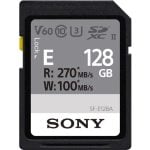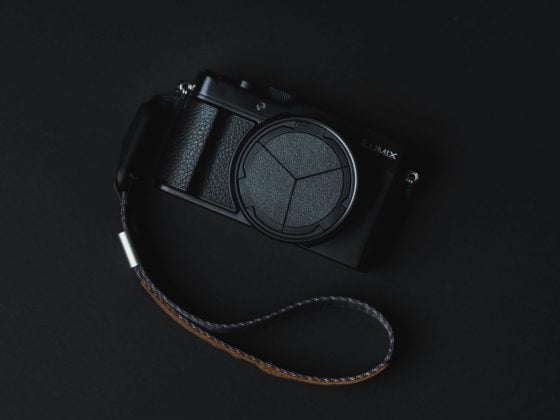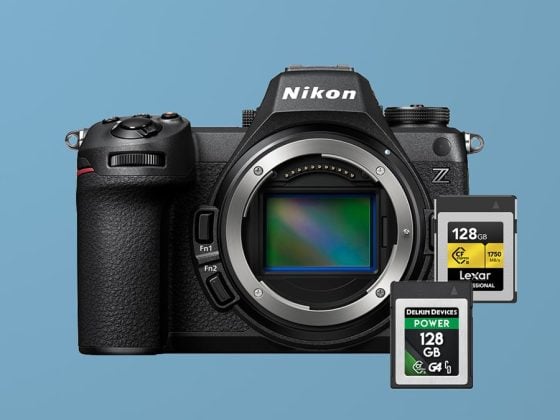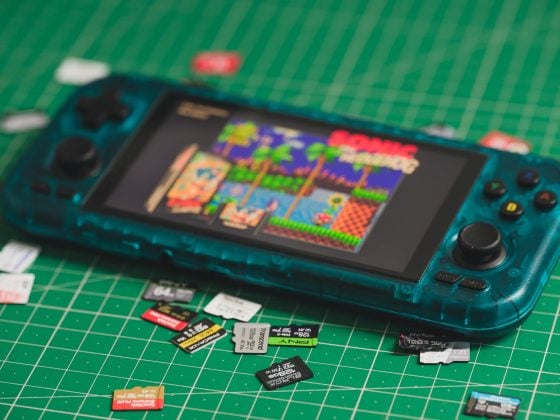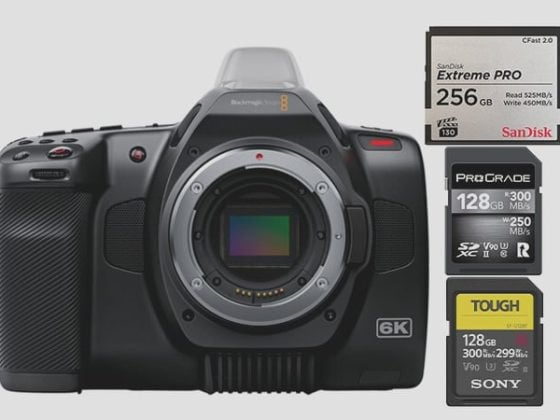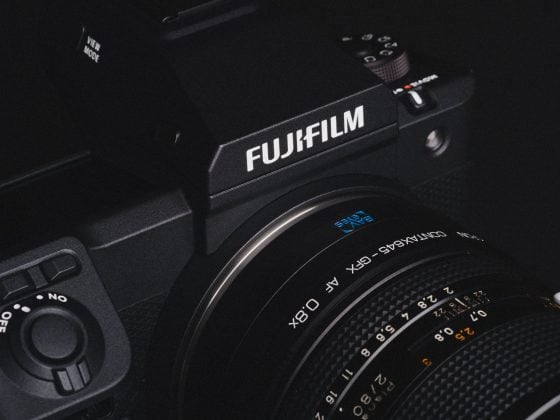The Sony A6000 was released in 2014 and has been one of the best-selling cameras for a long time. If you still own this camera and are looking for new memory cards or to pick one up on the second-hand market, you may wonder what great cards are available today. This guide will teach you important memory card information and help you to find the best ones for the Sony A6000.
Recommended Memory Cards Sony A6000
The Sony A6000 can use UHS-I SD cards, which are pretty standard and easy to find. You can also use UHS-II cards, but they won’t improve write speed.
The A6000 needs a card to write at least 6.25MB/s for 1080p video recording. You can use U3 or U1 cards for this.
The A6000 can use memory cards up to 128GB, so you can use 64-128GB cards without problems. The A6000 cannot write faster than about 35MB/s, so you do not need to buy the most expensive cards.
Here are some great recommendations for some of the latest cards. Take a look at the Sony E cards on this list. They have UHS-I write speeds and UHS-II read speeds, making them a great value for this camera.
| Recommended SD Cards | Speed Class | USB Write | USB Read | Links | |
|---|---|---|---|---|---|
| SD UHS-II V60 | UHS-II | Hide | Hide | ||
| Sony E v60 256GB | UHS-II | https://geni.us/ARfXs | Amazon / B&H | ||
| UHS-I U3 | UHS-I | Hide | Hide | ||
| Sandisk Extreme Pro 32/64/128GB | UHS-I | 144 | 172 | https://geni.us/AjId | Amazon / B&H |
| Kingston CanvasGo! 128/256/512GB | UHS-I | 124 | 161 | https://geni.us/oJU7q | B&H |
| Sony 95 | UHS-I | 81 | 90 | https://geni.us/wnX8rG | Amazon |
| Delkin Advantage 32-1TB | UHS-I | 77 | 93 | https://geni.us/HlTWWVh | Amazon / B&H |
Memory Card Speed Tests
I did these tests back when the camera was still released. You can see how fast the cards are in this camera. The camera cannot use the full speed of some cards. Most of these cards have changed since 2015, so look at the suggestions above or the SD memory card guide for more choices. You can also look at the suggestions for Sony cameras if you have another Sony camera with this one.
| SD Memory Cards | USB 3.0 Read | USB 3.0 Write | Sony A6000 |
| UHS-II | |||
| Lexar 64GB 2000x UHS-II U3 | 272.7 MB/s | 244.5 MB/s | 33.96 MB/s |
| Transcend 64GB UHS-II U3 | 290.2 MB/s | 182.1 MB/s | 33.40 MB/s |
| Delkin 64GB SDHC UHS-II U3 | 253.5 MB/s | 219.6 MB/s | 33.33 MB/s |
| Toshiba 64GB UHS-II U3 | 258.8 MB/s | 226.5 MB/s | 32.99 MB/s |
| Lexar 1000x 64GB UHS-II U3 | 147.4 MB/s | 78.4 MB/s | 32.40 MB/s |
| Sandisk Extreme Pro 64GB UHS-II U3 | 260.5 MB/s | 214.8 MB/s | 31.44 MB/s |
| UHS-I | |||
| Kingston 64GB SDXC U3 | 98.1 MB/s | 90.4 MB/s | 34.79 MB/s |
| Sandisk Extreme Pro 64GB U3 | 98.6 MB/s | 90.8 MB/s | 34.37 MB/s |
| Sandisk Extreme Plus 64GB U3 | 99.0 MB/s | 64.4 MB/s | 34.32 MB/s |
| Sandisk Extreme 64GB U3 | 72.43 MB/s | 54.1 MB/s | 34.27 MB/s |
| Samsung 64GB Pro U3 | 97.7 MB/s | 78.6 MB/s | 33.77 MB/s |
| Samsung 64GB Pro+ U3 | 97.5 MB/s | 87.3 MB/s | 33.74 MB/s |
| Samsung Pro 64GB U1 | 96.3 MB/s | 82.2 MB/s | 33.72 MB/s |
| Transcend 64GB U3 | 96.7 MB/s | 68.4 MB/s | 32.80 MB/s |
| PNY 64GB U1 | 96.5 MB/s | 66.5 MB/s | 32.93 MB/s |
| Lexar 600x 64GB U1 | 95.4 MB/s | 64.8 MB/s | 32.72 MB/s |
| Lexar 633x 64GB U3 | 93.3 MB/s | 67.3 MB/s | 32.50 MB/s |
| PNY 64GB U3 | 96.5 MB/s | 66.1 MB/s | 32.21 MB/s |
| Sony 64GB U3 | 96.5 MB/s | 84.5 MB/s | 32.18 MB/s |
| Samsung 64GB EVO U1 | 47.7 MB/s | 27.3 MB/s | 24.02 MB/s |
The Sony A6000 does not need a very fast SD card because it limits how fast it can write data to the card. This limit is the camera’s internal bus speed. All the UHS-I cards have similar write speeds in this camera.
Another interesting thing is that the write speed is slower when you shoot JPEG only. It is only 10-12MB/s, which is low for a camera. This may be because the camera can only process one thing simultaneously. Other Sony cameras like the Sony A7s and the Sony A7r have the same problem.
Camera Specs
Sensor Size: 24.3MP APS-C
Memory Card Format: UHS-I
Video Resolution: 1080p60
Memory Card Capacity: Up to 128GB
Video Codec: XAVC S 50Mbps
Sony A6000 Speeds Stats
The Sony A6000 can shoot at a fast speed of 11 frames per second, and each file is about 25MB.
11fps
This means the camera needs a lot of data to shoot at 11fps. It needs 11 x 25 = 275MB of data per second.
Buffer
The camera’s buffer can store 49 JPEG shots or 21 RAW shots, about 512MB of space.
Card speed
The card speed does not affect how fast you can shoot but how long it takes to save the files to the card. The camera will slow down when the buffer is full until the files are saved.
SDXC VS SDHC
SDXC cards are needed for the Sony A6000 if you want to record video in XAVC S format, a high-quality video format that requires a lot of space. If you only take photos, then you do not need SDXC cards.
SDHC cards cannot be changed to exFat64 file system to record XAVC S video. They can only use Fat32 file system and record other video formats. Any card 32GB or smaller will be SDHC.
| **This website contains affiliate links. We will earn a small commission on purchases made through these links. Some of the links used in these articles will direct you to Amazon. As an Amazon Associate, I earn from qualifying purchases. |

